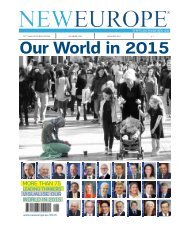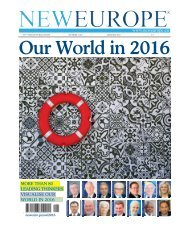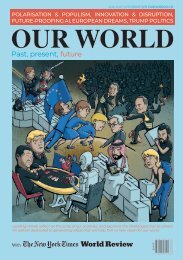Our World in 2018
Leading minds reflect on the state of our societies, and examine the challenges that lie ahead. An edition dedicated to generating ideas that will help form a new vision for our world.
Leading minds reflect on the state of our societies, and examine the challenges that lie ahead. An edition dedicated to generating ideas that will help form a new vision for our world.
You also want an ePaper? Increase the reach of your titles
YUMPU automatically turns print PDFs into web optimized ePapers that Google loves.
the outlook. For example, annual
per capita growth in the advanced
economies averaged 2.2% in the
decade following 1995, and naturally
dipped following the crisis; but even
for the years between now and 2022,
annual per capita growth will reach
only 1.4%, according to International
Monetary Fund projections.
Absent some unforeseen
surge in productivity, the
current upswing in advanced
economies will inevitably moderate:
growth will slow as monetary policies
as countries are forced to consolidate
public finances strained by high
government debts and burgeoning
spending on pensions and health
care. In turn, slower overall growth
will make it harder to counter slow
wage growth, especially among the
unskilled, adding to the burden of
inequality and resulting resentments.
Many emerging-market and lowincome
economies will also face
headwinds.
Economic policymakers throughout
the world therefore face two major
challenges. First, can they act to
bolster output levels over the longer
term? Second, can they increase their
economies’ resilience and inclusiveness
while reducing the likelihood that the
current upswing ends in an abrupt
slowdown or even a new crisis?
These two challenges are closely
interrelated. Today’s favorable
economic conditions provide a
window of opportunity for policies
that can meet both.
The key to improving long-run
growth prospects and perceived
fairness is investment in people.
Educational investment increases
workers’ productivity and ability to
navigate structural transformation,
whether due to trade or technology.
Apprenticeship programs, moreover,
can save resources wasted through
high youth unemployment, while
counseling and retraining can
prolong working lives. Conversely,
failure here would be destabilizing,
as weak job prospects and income
inequities would fuel a stronger voter
backlash against multilateralism in
international relations and prudent
economic policies at home.
As essential as these investments
are, they require fiscal outlays. To
avoid inflating already-high publicdebt
burdens, governments will need
to reform tax regimes, enhancing
revenues without discouraging
growth.
Tax systems should be designed
to increase inclusion, not least by
promoting labor-force participation.
And citizens will have more
the channels for tax avoidance used
by big corporations and the rich are
.
Greater economic resilience is
.A
wane, financial instability poses an
increasing threat. Many countries
improved their macro-prudential
frameworks after the crisis, including
by raising banks’ capital and liquidity.
The prolonged period of low interest
rates following the crisis has,
however, led to a search for yield and
global debt buildup that could prove
problematic for some borrowers
once interest rates rise.
Several economic studies,
including from the IMF, suggest
that even if debt booms are
associated with faster growth in
the short run, they often end in
tears. Some countries must rein in
excessive credit growth and reduce
issuance, while others still need to
address the bad loans left behind by
previous recessions. Countries should
strengthen financial oversight as
OUR ECONOMIES
well as their international regulatory
cooperation, thereby avoiding a race
to the bottom in prudential policy.
Emerging and low-income
economies face some challenges
that resemble those in advanced
economies.
China’s leaders, for example,
have recognized the imbalances
in the country’s financial system
and are moving to address them.
But several challenges are distinct.
Notwithstanding the recent uptick
in commodity prices, commodityproducing
countries need to diversify
their economies’ export mixes to
support future growth.Because the
current upswing is broad, the moment
is also ripe for action on a range of
multilateral priorities. Probably the
most urgent of these is to slow longterm
climate change resulting from
dependence on fossil fuels.
IMF research shows how
vulnerable low-income countries are
to the likely temperature increase
over the rest of this century, even
if the 2015 Paris climate agreement
achieves its goal of holding the
increase to less than 2º Celsius above
pre-industrial levels. But advanced
economies are vulnerable as well,
including through the spillovers of
political instability and mass migration
originating in warmer regions. It is
in their interest to embrace more
ambitious emissions targets and aid
low-income countries’ adaptation
.
The bottom line is that reveries of
an economic sweet spot risk lulling
policymakers into a false sense of
security. Current good times are most
likely temporary – indeed, the forces
producing this upswing may not last
much longer. To make the recovery
more durable, policymakers should
seize the current opportunity and
reform while they still can. Otherwise,
the future may be closer than we
think.
OUR WORLD | 2018
Copyright: Project Syndicate, 2018. www.project-syndicate.org
57










